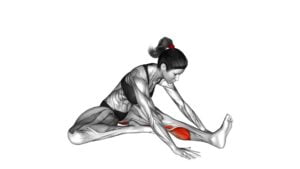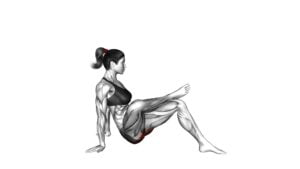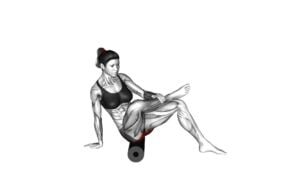Wrist Extensor Stretch (female) – Video Exercise Guide & Tips

Are you looking to improve your wrist flexibility and prevent injury?
Watch This Exercise Video
This video exercise guide is here to help! In just a few minutes, you'll learn proper form and technique for the wrist extensor stretch.
Whether you're a beginner or experienced, this stretch can be modified to suit your level. Avoid common mistakes and discover tips for incorporating this stretch into your routine.
Get ready to give your wrists the care they deserve!
Key Takeaways
- The wrist extensor stretch improves flexibility and increases range of motion in the wrists.
- It reduces the risk of wrist injuries and targets the extensor muscles in the forearm.
- Incorporating the stretch at least three times a week and setting aside dedicated time for stretching is beneficial.
- Beginners can modify the exercise by using lighter resistance bands, performing the stretch with the arm supported on a table or bench, and gradually progressing to thicker resistance bands.
Benefits of the Wrist Extensor Stretch
To understand the benefits of the Wrist Extensor Stretch, you should know that it can help improve flexibility and reduce the risk of wrist injuries.
The Wrist Extensor Stretch is a simple and effective exercise that targets the muscles on the back of your forearm, known as the extensor muscles. These muscles play a crucial role in wrist movement and stability.
By performing the Wrist Extensor Stretch regularly, you can increase the flexibility of these muscles, allowing for a wider range of motion in your wrists. This increased flexibility can be beneficial in various activities, such as sports, weightlifting, and even everyday tasks that require wrist movement.
Additionally, the Wrist Extensor Stretch helps to prevent wrist injuries. By stretching and strengthening the extensor muscles, you can improve the stability of your wrists, making them less prone to strains, sprains, and other common injuries.
Incorporating the Wrist Extensor Stretch into your fitness routine can contribute to your overall wrist health and enhance your performance in various physical activities.
Proper Form and Technique
Start by positioning yourself in a comfortable seated or standing position.
To ensure proper form and technique during the wrist extensor stretch, follow these guidelines:
- Place your forearm on a flat surface, such as a table or desk, with your palm facing down.
- Gently extend your wrist by pulling your hand back towards your body, using your other hand to assist if needed.
- Hold the stretch for 15-30 seconds, feeling a gentle stretch in the top of your forearm.
- Repeat the stretch on the other arm.
Proper form and technique are crucial for preventing injuries and promoting hand and wrist health.
By incorporating ergonomic practices into your daily routine, you can reduce strain on your wrists and improve overall comfort. Here are some additional tips:
- Maintain a neutral wrist position while using your computer or performing repetitive tasks.
- Use tools and equipment that are ergonomically designed to support your hand and wrist.
- Take regular breaks to stretch and rest your hands and wrists.
- Gradually increase the intensity and duration of your stretches over time.
Modifications for Beginners
As a beginner, it's important to make modifications to the wrist extensor stretch to ensure proper form and technique. One modification option is to perform the stretch with your arm supported on a table or bench. This can help alleviate any strain on your wrist and forearm muscles.
Another modification is to use a lighter resistance band or no resistance band at all. This allows you to focus on mastering the movement and gradually increase the intensity as you progress.
When starting out, it's also helpful to perform the exercise with your palm facing down instead of up. This can reduce the amount of tension on your wrist extensor muscles and make the stretch more manageable.
In terms of equipment needed, all you really need is a resistance band. You can easily find these at any fitness store or online. As you become more advanced, you can consider using a thicker resistance band for a greater challenge.
Common Mistakes to Avoid
One crucial aspect to consider when performing the wrist extensor stretch is avoiding common mistakes. By being aware of these mistakes, you can ensure that you're getting the most out of your exercise routine and minimizing the risk of injury. Here are some common mistakes to avoid:
- Using excessive force: It's important to remember that the wrist extensor stretch should be a gentle and controlled movement. Avoid using excessive force or pulling too hard, as this can strain the muscles and lead to injury.
- Not maintaining proper form: Proper form is essential for any exercise, and the wrist extensor stretch is no exception. Make sure to keep your wrist in a neutral position and avoid excessive bending or twisting. This will help target the correct muscles and prevent unnecessary strain.
By avoiding these common mistakes, you can ensure that you're performing the wrist extensor stretch correctly and safely.
However, if you find that the wrist extensor stretch isn't suitable for you or if you want to mix up your routine, there are alternative exercises you can try. Some alternatives include wrist flexor stretches, forearm pronation and supination exercises, and wrist circles. These exercises target different muscles in the forearm and can provide variation to your workout routine. Remember to consult with a professional before incorporating any new exercises into your routine.
Tips for Incorporating the Wrist Extensor Stretch Into Your Routine
To optimize your exercise routine and maximize the benefits of the wrist extensor stretch, incorporate this stretch into your routine at least three times a week. Consistency is key when it comes to stretching, so make sure to set aside dedicated time for this exercise.
To progress the wrist extensor stretch and challenge yourself further, there are a few ways you can modify the exercise. One variation is to use a resistance band or towel to add resistance to the stretch. Simply wrap the band or towel around your hand and gently pull it towards you while maintaining the stretch. This will help to strengthen the wrist extensor muscles over time.
Another variation is to perform the stretch in different positions. For example, you can try doing the wrist extensor stretch while standing or kneeling, rather than sitting. This will engage different muscles and provide a new challenge for your wrists.
Remember to listen to your body and start slowly. If you experience any pain or discomfort, ease off the stretch and consult a healthcare professional if necessary. By incorporating variations and progressing gradually, you can continue to challenge your wrists and improve flexibility and strength.
Frequently Asked Questions
Can the Wrist Extensor Stretch Help With Carpal Tunnel Syndrome?
The wrist extensor stretch can be beneficial for carpal tunnel syndrome. By stretching the wrist extensor muscles, you can help improve overall wrist health and reduce the symptoms of carpal tunnel syndrome.
To perform the stretch effectively, start by extending your arm in front of you with your palm facing down. Use your opposite hand to gently bend your wrist downward until you feel a stretch in the top of your forearm. Hold for 30 seconds and repeat on the other side.
How Often Should I Perform the Wrist Extensor Stretch?
To maximize the benefits of the wrist extensor stretch, it's recommended to perform it regularly. Consistency is key! Aim to incorporate the stretch into your daily routine.
This will help improve flexibility and reduce tension in the wrist extensor muscles. When performing the stretch, remember to use proper technique and listen to your body.
Don't push yourself too hard and stop if you feel any pain or discomfort.
Is It Necessary to Warm up Before Doing the Wrist Extensor Stretch?
Before engaging in the wrist extensor stretch, it's highly recommended to warm up your muscles. Warming up helps to increase blood flow and flexibility, which can reduce the risk of injury during the exercise.
Additionally, warming up prepares your muscles for the wrist extensor stretch by loosening them up and making them more pliable.
Can I Do the Wrist Extensor Stretch if I Have a Wrist Injury?
If you have a wrist injury, it's important to modify the wrist extensor stretch to avoid further damage. Instead of the traditional stretch, try alternative exercises that don't put as much strain on your wrist.
Consult with a healthcare professional or a physical therapist for guidance on which exercises would be appropriate for your specific injury. Taking care of your wrist is crucial to prevent worsening the injury and promoting healing.
Are There Any Contraindications or Precautions for Performing the Wrist Extensor Stretch?
When it comes to the wrist extensor stretch, it's important to know about any contraindications or precautions.
Before doing the stretch, it's recommended to consult with a healthcare professional, especially if you have a wrist injury or any specific condition that may be affected by this exercise.
They can provide guidance on whether it's safe for you to perform the wrist extensor stretch and if any modifications or precautions are necessary to prevent further injury or discomfort.
Conclusion
Incorporating the wrist extensor stretch into your routine can provide numerous benefits, such as improving flexibility and reducing the risk of wrist injuries.
By following proper form and technique, beginners can gradually build strength and avoid common mistakes.
Remember to listen to your body and make any necessary modifications.
By consistently practicing this stretch, you can enhance your overall wrist health and enhance your performance in various activities that require wrist mobility and strength.

Author
Years ago, the spark of my life’s passion ignited in my mind the moment I stepped into the local gym for the first time. The inaugural bead of perspiration, the initial endeavor, the very first surge of endorphins, and a sense of pride that washed over me post-workout marked the beginning of my deep-seated interest in strength sports, fitness, and sports nutrition. This very curiosity blossomed rapidly into a profound fascination, propelling me to earn a Master’s degree in Physical Education from the Academy of Physical Education in Krakow, followed by a Sports Manager diploma from the Jagiellonian University. My journey of growth led me to gain more specialized qualifications, such as being a certified personal trainer with a focus on sports dietetics, a lifeguard, and an instructor for wellness and corrective gymnastics. Theoretical knowledge paired seamlessly with practical experience, reinforcing my belief that the transformation of individuals under my guidance was also a reflection of my personal growth. This belief holds true even today. Each day, I strive to push the boundaries and explore new realms. These realms gently elevate me to greater heights. The unique combination of passion for my field and the continuous quest for growth fuels my drive to break new ground.







